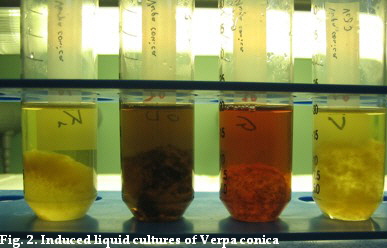|
1. Biogeography: Diversity and distribution of the yellow morels in Germany and France
In a first study we analysed the genetic diversity and distribution of yellow morels (M. esculenta-group) in Germany and adjacent countries. Based on analysis of the nuclear ribosomal ITS-region (Internal Transcribed Spacer) we found three distinct genetic types, namely M. crassipes, M. esculenta and M. spongiola (Fig. 1).
Fig. 1. Distribution of species belonging to the M. esculenta group in Germany and France, based on ITS nrDNA sequences and RFLP; symbols indicate species as follows: squares M. esculenta, asterisks M. spongiola, diamonds M. crassipes.
Meanwhile we screened more species (see Table) by RFLP or sequencing of the ITS. No new ITS sequences (types) were discovered for Central Europe so far.
|
Species
|
Origin
|
Date, collector
|
|
M. crassipes
|
Italy, Boscodi S. Apuese, Bordostrada
|
21.04.2004 Claudia Perini
|
|
M. crassipes
|
Montenegro, Lovcen National Park
|
1998 Lakusic
|
|
M. esculenta
|
Poland, Krakow, under Acer
|
04.2004 Przemyslaw Ryszka
|
|
M. spongiola
|
Germany, Reinsdorf, orchard
|
05.2006 Kellner
|
|
2. Ecology: Analyses of laccase-like multicopper oxidases to discover the potential capacity for lignin degradation

In this study the genetic and functional diversity of laccase-like multicopper oxidases was Fig. 2. Induced liquid cultures of Verpa conicainvestigated. Laccases are involved in degradation of lignins, but also in many other processes. Laccase production was stimulated by addition of guaiacol, o-dianisidine dihydrochloride or vanillic acid (Fig. 2) and monitored via oxidation of ABTS. Morchella conica and Verpa conica showed the strongest response to the addition (Fig. 3). Thus, both strains were submitted to an analysis of their laccase gene expression.
Fig. 3. Laccase activity after induction of M. conica and V. conica. Laccase gene families according to a cluster analysis of laccase sequence fragment between cbr I and cbr II. The expressed genes are marked “E”.
As a result, two different laccase genes could observed to be expressed in M. conica and V. conica (Fig. 3&4). Both genes belonged to previously characterised gene families II and III and might therefore be responsible for the extracellular laccase activity (Fig. 3&4). Analyses of the proteins to match them to the accordingly expressed genes failed so far. Nevertheless it seems that only certain laccase gene families might contribute to degradation processes. Moreover this study had shown the need to investigate also soil inhabiting ascomycetes for their soil turnover, i.e. degradation processes.
Fig. 4. Laccase protein alignment between cbr I and cbr II. The conserved aspartate, involved in electron transfer is marked “1” and the conserved cysteine, characteristic for eukaryotic laccases with “2”. Colors represent the four characterised gene (protein) families.
The used laccase gene alignment can be downloaded here [.nex] or at TreeBASE.
References:
Kellner H., Luis P., Buscot F. (2007): Diversity of laccase-like multicopper oxidase (LMCO) genes in Morchellaceae: identification of genes potentially involved in extracellular activities related to plant litter decay. FEMS Microbiology Ecology 61: 153-163.
doi:10.1111/j.1574-6941.2007.00322.x
Kellner H., Renker C., Buscot F. (2005): Species diversity within Morchella esculenta group (Ascomycota: Morchellaceae) in Germany and France. Organisms Diversity & Evolution 5: 101-107.
doi:10.1016/j.ode.2004.07.0016.0
|